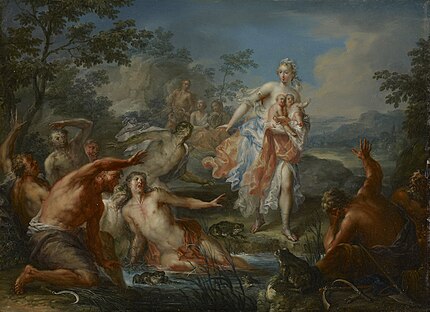Leto
In Greek mythology, Leto (in ancient Greek Λητώ Lêtố) is a daughter of the titans Ceo and Phoebe and, in the Olympian pantheon, mother to Zeus of the twins Apollo and Artemis. In Roman mythology, her equivalent, as the mother of Phoebus and Diana, is Latona. With her sister Asteria hers, she was revered as a goddess of the night and alternately of the light of day.
Worship
In Crete, in the city of Dreros, the Greek archaeologist Spyridon Marinatos excavated in 1935 a hearth temple from the 8th century a. in which he found three cult statuettes of the Apollonian triad: Apollo, Artemis and Leto. The Leto statuette was made in the early orientalizing style of the late 20th century VIII a. C. (or around 650 B.C.), using the sphyrelaton technique: hammering sheets of bronze onto a wooden core that gave them shape. It is 40 or 45 cm, and has a geometric-style body and dress that already anticipates the Daedalic style. Walter Burkert points out in Greek Religion that in Phaistos it appears related to an initiation rite.
Leto was the chief goddess of Anatolian Lycia. Her sanctuary, the Letoon near Xanthus, united the Lycian confederation of city-states. The people of Cos also claimed Leto as their own.
A measure of such a primordial goddess Leto can be recognized in her Titan father, whose name “Ceo” links him to the sphere of heaven from pole to pole; and her mother, whose name "Phebe" is precisely the epithet "pure" and "purifier" of the full moon.
Birth of Artemis and Apollo
Zeus had attempted to rape Leto's sister, Asteria, who had escaped by transforming into a quail, throwing herself into the sea and becoming the floating island Ortigia.
Hera chased Leto and managed to get no one to welcome her except the island Ortigia, (Asteria) which was deserted. Hera tried to prevent her birth by forbidding her daughter Ilithia, goddess of childbirth, to attend her. When Leto was already 9 days late, her pain moved the gods, who caused Artemis to be born first to help her mother in the birth of Apollo.
The island Ortigia was fixed to the bottom with 4 columns, and changed its name to Delos, which means bright (for Apollo, god of light). Python, son of Gaia, pursued Leto to kill her, since her destiny was that she would die from childbirth, but he did not succeed and four days after he was born from her, Apollo killed the serpent with the arrows of she.
Persecuted by Hera, Leto, Artemis and Apollo arrived at a pond, and when the mother was going to give her children a drink, some peasants, instigated by Hera, stirred up the water and clouded it with mud. Then Leto, enraged, punished them by turning them into frogs.
Apollo and Artemis were great protectors of their mother, and killed the giant Ticio for trying to rape her.
They also defended her from the ridicule of Niobe, Amphion's wife, with whom she had had 7 male and 7 female children, and who mocked Leto for her few offspring. Niobe was punished to see all her children except Chloris die by the arrows of Apollo and Artemis.
Contenido relacionado
Gothic art
Methodism
Barceo
